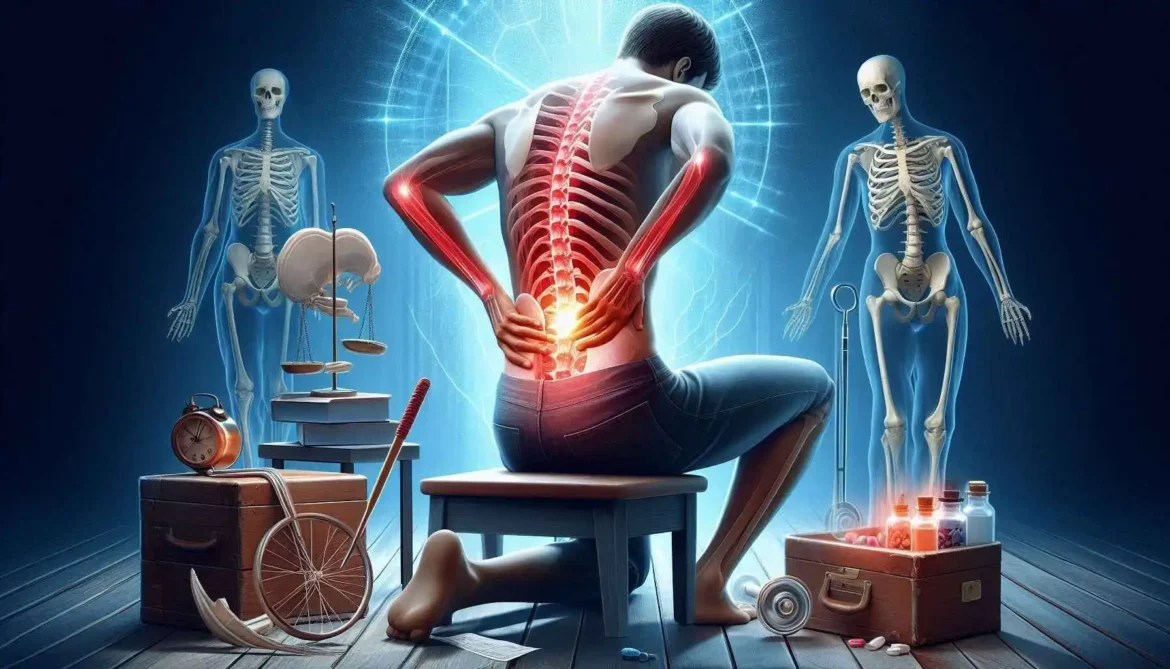
Unraveling the Mystery of Back Pain: Causes, Treatments, and Why It Often Travels South
Back pain. It’s a common adversary, an unwelcome guest in many of our lives. Whether it’s a sudden, sharp jab or a persistent, dull ache, most of us will experience it at some point. It can disrupt our work, our sleep, and our ability to enjoy simple activities. But what exactly causes this widespread discomfort, how do we manage it, and perhaps most perplexing, why does it so often decide to take a trip down our legs?
We understand that dealing with back pain can be frustrating and sometimes frightening, especially when symptoms extend beyond the back itself. In this article, we’ll explore the intricate nature of back pain, delve into its common culprits, discuss effective treatment strategies, and specifically address the connection that sends pain signals traveling into our lower limbs.
“The body is a complex machine, but sometimes the simplest things can throw it out of whack.” – This often rings true for back pain, where a minor strain can feel monumental.
What is Back Pain, Anyway?
Our backs are marvels of engineering. The spine, a column of vertebrae, disks, nerves, muscles, and ligaments, provides support, allows movement, and protects the spinal cord. Back pain arises when something goes wrong with one or more of these components. Because this system is so complex and interconnected, identifying the exact source of pain can sometimes be challenging, even for healthcare professionals.
We primarily focus on pain in the lumbar (lower) spine, as this is the most common site for significant, disruptive pain and the region most frequently associated with symptoms radiating into the legs.
The Usual Suspects: Common Causes of Back Pain
Back pain isn’t a single condition; it’s a symptom with a multitude of potential causes. We often categorize causes into acute (sudden, short-term) and chronic (lasting three months or longer). Here are some of the most frequent reasons we experience back pain:
- Musculoskeletal Strain: This is perhaps the most common cause. It involves injuries to the muscles and ligaments supporting the spine.
- Sprains: Overstretching or tearing of ligaments.
- Strains: Injuries to muscles or tendons.
- Often caused by sudden movements, lifting heavy objects improperly, or awkward bending.
- Structural Problems: Issues with the components of the spine itself.
- Herniated (Slipped) Discs: The soft, gel-like center of a spinal disc pushes through a tear in the outer ring. This can press on nearby nerves.
- Bulging Discs: Similar to herniation, but the disk hasn’t ruptured. It can still press on nerves.
- Osteoarthritis: Wear and tear on the joints of the spine, leading to inflammation and pain. This can also narrow the space around the spinal cord (spinal stenosis).
- Spinal Stenosis: Narrowing of the spinal canal, putting pressure on the spinal cord and nerves.
- Spondylolisthesis: A condition where one vertebra slips forward over the one below it.
- Nerve Compression and Irritation: This category overlaps with structural issues but specifically highlights the impact on nerves. Pressure or irritation on spinal nerves can cause pain not only in the back but also radiating elsewhere.
- Lifestyle and Other Factors: Not always direct injuries or structural issues, but contributing factors.
- Poor Posture: Slouching or improper alignment can strain the spine over time.
- Excess Weight: Puts extra stress on the back.
- Lack of Exercise: Weak back and abdominal muscles can’t properly support the spine.
- Improper Lifting: Using your back instead of your legs.
- Stress and Mental Health: Can lead to muscle tension and exacerbate pain perception.
- Smoking: Can reduce blood flow to the spine and slow healing.
Why Does Back Pain Sometimes Go Down the Legs? (The Sciatica Connection)
This is where many people feel particularly worried. Experiencing pain, numbness, or tingling that originates in the lower back and shoots down one or both legs is often referred to as sciatica. This isn’t a cause itself, but rather a symptom indicating irritation or compression of the sciatic nerve or the nerve roots that form it.
Let’s understand this connection:
- The Sciatic Nerve: The sciatic nerve is the longest and thickest nerve in your body. It’s actually composed of several nerve roots from the lower (lumbar) spine (L4, L5) and the sacrum (S1, S2, S3). These roots bundle together deep in the buttock and travel down the back of the leg, branching out to supply sensation and motor control to the thigh, lower leg, and foot.
- The Mechanism: When something in the lower back compresses or irritates one of these nerve roots before they form the sciatic nerve, or irritates the nerve itself further down, the pain signals travel along the nerve pathway.
- Common Causes for Leg Pain Radiation:
- Herniated Lumbar Disc: This is arguably the most common cause. If a herniated disc presses on a specific nerve root in the lower back (like L5 or S1), the pain will radiate down the path of that nerve root, which contributes to the sciatic nerve.
- Spinal Stenosis: The narrowing of the spinal canal can compress the spinal cord or the nerves exiting the spinal canal, leading to pain that radiates down the legs, often worsening with walking (neurogenic claudication).
- Bone Spurs (Osteophytes): Caused by arthritis, these bony growths can encroach on the space where nerves exit the spine.
- Spondylolisthesis: When a slipped vertebra narrows the nerve exit (“foramen”).
- Piriformis Syndrome: Less commonly, the sciatic nerve can be compressed by the piriformis muscle in the buttock, though this cause originates outside the spine itself.
So, when we feel that shooting pain, numbness, or weakness in our leg that starts in the back, it’s usually the nervous system telling us that a nerve in the lower back is being bothered. The location and specific type of leg symptom can often give clues to which nerve root is affected.
Finding Relief: Treatment Approaches
The good news is that most back pain, even when it radiates to the legs, improves with conservative treatment. Our approach to managing back pain typically involves a combination of strategies aimed at reducing pain, restoring function, and preventing recurrence.
Back pain and leg pain are common ailments that can have a significant impact on a person’s quality of life. While there are many potential causes of back pain and leg pain, there are also many treatment options available, ranging from self-care measures to more invasive treatments. By taking steps to prevent back pain and leg pain, such as maintaining good posture, lifting with care, exercising regularly, and maintaining a healthy weight, you can reduce your risk of developing these conditions.
Here’s a table summarizing the causes, symptoms, and treatment options for back pain and leg pain:
| Cause | Symptoms | Treatment |
| Poor posture | Pain, stiffness, discomfort in the back | Rest, ice, heat, over-the-counter pain medications, physical therapy, stretching exercises, strengthening exercises |
| Repetitive strain injuries | Pain, stiffness, discomfort in the back | Rest, ice, heat, over-the-counter pain medications, physical therapy, stretching exercises, strengthening exercises |
| Muscle or ligament strain | Pain, stiffness, discomfort in the back | Rest, ice, heat, over-the-counter pain medications, physical therapy, stretching exercises, strengthening exercises |
| Herniated or bulging discs | Pain, numbness, tingling, or weakness in the back, legs, or feet | Physical therapy, stretching exercises, strengthening exercises, prescription pain medications, injections, surgery |
| Spinal stenosis | Pain, numbness, tingling, or weakness in the legs | Physical therapy, stretching exercises, strengthening exercises, prescription pain medications, injections, surgery |
| Osteoarthritis | Pain, stiffness, inflammation in the spine | Physical therapy, stretching exercises, strengthening exercises, prescription pain medications, injections |
| Osteoporosis | Pain, stiffness, inflammation in the spine | Physical therapy, stretching exercises, strengthening exercises, prescription pain medications, injections, surgery |
And here’s a relevant quotation from Hippocrates, the father of medicine: “Walking is man’s best medicine.” Regular exercise, including walking, can help prevent back pain and leg pain by keeping the muscles in the back and legs strong and flexible.
By understanding the causes, symptoms, and treatment options for back pain and leg pain, and by taking steps to prevent these conditions, you can enjoy a happier, healthier, and more active lifestyle.





